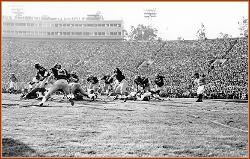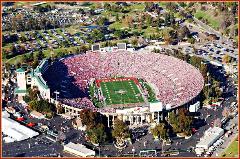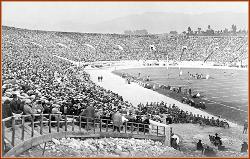




November 8, 1924 - First Game - Texas loses to Baylor 28-10. On November 27, Texas defeated Texas A&M 7-0 in the dedication game.
1926 - A north-end horseshoe with 13 arches is added increasing stadium capacity to 40,500. Cost: $125,000.
1948 - Twenty-six rows are added to the east and west stands. In addition, a south section is built to push stadium capacity to 60,130. Cost: $1.4
million.
1955 - Eight sets of 100-foot towers are erected, four on the east side and four on the west to fully illuminate Memorial Stadium. On September
17,1955, 47,000 attend the first night game in Texas football history. Texas Tech defeated the Longhorns 20-14 for the first home-opening loss
in UT history. Cost: $200,000.
1967-1972 - Artificial turf, a tartan track and aluminum seats are installed at Memorial Stadium. On September 27, 1969, 65,200 fans looked on
as Texas defeated Texas Tech 49-7 in the first game played on UTs new artificial surface. The 15,990 seat upper deck was in place for the 1971
season, increasing the stadium capacity to 77,809.
1986 - The Moncrief-Neuhaus Complex at the south end of the stadium is completed. The Complex includes the Texas weight room, training
facilities, meeting rooms and locker rooms. Cost: $7 million.
1989 - A new four-color animated scoreboard located at the north end of the stadium is unveiled for the home opener vs. Penn State.
1996 - Astro Turf is removed and a state-of-the-art Prescription Athletic Turf System is installed at the cost of $1.25 million. A Sony Jumbotron in-
stadium video system and retrofitted north end zone scoreboard are installed at the cost of $2.8 million.
1997 - Fourteen stadium suites are added to west side of stadium. Concession plaza and visitors locker room/track locker room are
reconstructed underneath west and northwest stands
1998 - Fifty-two stadium suites and a 13,000 square-foot club room designed for 1,200 people are added on the east side of the stadium. Also
on the east side, a 16-row, 5,000-seat upper deck is constructed to increase the seating capacity to 79,471.
1999 - The Mike A. Myers Stadium & Soccer Field, located east of the football stadium, is completed. The Royal - Texas Memorial Stadium track
oval is removed, new chairback seats are added to the west grandstand, and the field is lowered seven feet to accomodate new front rows and
600 new field level seats on the east and west grandstands. Stadium capacity is 80,092.
2002 - Prescription Athletic Turf replaced with TifSport Certified Bermuda grass
2006 - $15 million have been allocated by the Board of Regents for stadium renovations. Stage one, beginning November 14, 2005, involves
updating Bellmont Hall — which sits in the west end of the stadium — to meet newer safety codes set by the Austin Fire Department. Also
included are water sealing the stadium and the expansion of both the Centennial Room and eighth-floor press box.
$8 million are being spent on audiovisual improvements, the centerpiece of which is a 7,370 square foot high-definition Daktronics LED
scoreboard, aptly nicknamed "Godzillatron." The screen has a pixel resolution of 848 x 2064. Previously, two scoreboards were in place, one in
the south end and one in the north end. The new scoreboard replaces the one in the south end. The north end will not feature a scoreboard as it
has been removed in preparation for the addition of extra seats in the 2008 expansion. The new scoreboard also required the removal of the six
large flag poles that previously displayed the Six flags over Texas. These have been replaced by smaller flags.
At the time of its creation, Godzillatron was called the largest high-definition video screen in the world, though it was quickly surpassed by a larger
screen in Tokyo. It is still the largest high-definition video screen in collegiate sports. Depending on how the measurement is made, it may be the
largest high definition screen in the Western hemisphere. The Miami Dolphins have a high-definition screen with a larger diagonal measurement,
but Godzillatron has greater square footage.
2008 - Regents approved a US$149.9 million expansion plan (includes the $15 million 2006 renovations) to include a new memorial plaza and
new north end zone structure that is scheduled to be completed in August 2008. The new outdoor plaza at the northwest corner will be a
memorial to veterans, with a bronze tablet honoring Texas World War I deaths, a monument, landscaping, and new stadium entry gates between
two 115 foot towers, like those in the east grandstand. The expansion also consists of replacing the north end zone structure with a multi-level
complex that includes additional seats, club space, suites, athletic offices, academic-advising areas and a basement with gym space. Seating
capacity overall will rise to more than 90,000 from the current 85,123.
This project began just after the final home game of 2006, as the north end-zone is being expanded to make the lowest seats closest the field
while adding luxury boxes and an upper-deck. The lower deck is planned to be rebuilt for 2007, while the upper deck is planned to be ready for
2008.
Demolition work began on December 8, 2006 and demolition is expected to be finished in two months, with new construction beginning thereafter.

Artist's rendition of Darrell K. Royal-Texas Memorial Stadium north end zone after expansion.
|






